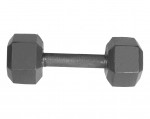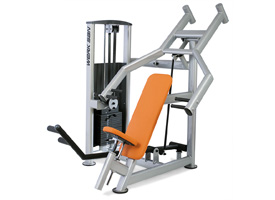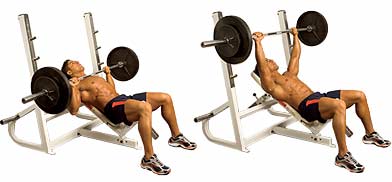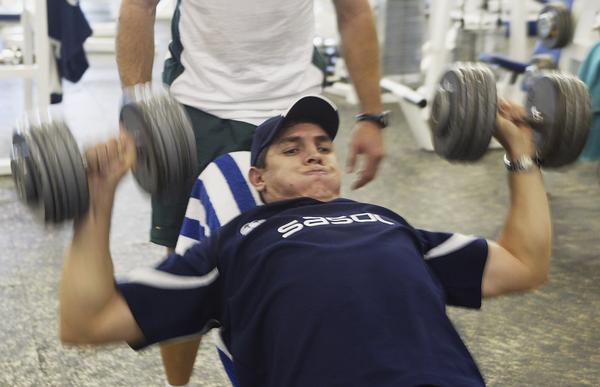-

Why Tennis Players Should Train With Free Weights
We shift gears today and take a look at strength training, the first time we’ve dealt with this area here on Tactical Tennis. Many times we see short highlight clips of pro players partaking in their physical training. However such videos typically feature them running speed ladder drills, or throwing medicine balls. These things make for much better highlight film than another hugely important aspect of preparing for competitive tennis: weight training.
Today we are going to focus specifically on training with free weights, and why it is important to do so as opposed to training on machines. The reasons to do so are three-fold:
1) Extends the effective range of contact points we can hit with strength
2) Reduces injuries
3) Improves our powerHow Our Joints Work
To understand how free weight training can benefit us as tennis players we first need to have a basic understanding of how our joints work. We’re going to simplify things a little for the sake of convenience. Most of the joints we train fall into one of two categories – hinge joints and ball joints. An example of a hinge joint would be your knee – it bends in one direction. An example of a ball joint is your shoulder – it can rotate hopefully freely through an entire circle. For each joint there are prime mover muscles – those muscles that, as the name suggests, provide the major movement. With your knee those muscles are your hamstrings (flexion) and quads (extension). The hamstrings bend the knee, the quads make it straight again. Then we have the fixator muscles which stabilize the joint and prevent undesired movement. An example of these in the shoulder would be the rotator cuff (which is actually four muscles). So we have the prime movers bending or rotating the joint, and the fixator muscles stabilizing it.
How Free Weights Help
To understand the difference between free weights and using machines we’ll take the example of an incline bench press machine, pictured above. When one uses the incline bench press machine, the hands are locked in place and can only move along the tracks of the machine. They cannot widen or narrow their width relative to the shoulders – the arms have very restricted movement. This means that the muscles of the chest are isolated – absent the ability to move except in the direction pre-determined by the machine none of the stabilizing muscles in the shoulder are required to prevent the arms from rotating out. To put it another way, the machine is doing the job of the stabilizing muscles for them.
So let’s take an intermediate step – incline bench press using a barbell. Now it is possible for the weight to shift to either side, and the stabilizing muscles must work to prevent that from happening. However, as the hands are on the barbell together, they are connected by a rod of steel which means that they work cooperatively. The right hand can only shift right if the left hand also shifts right – which means that the muscles of both shoulders are working in conjunction to prevent this from happening. This is a definite improvement over the incline bench machine, but still not ideal. It is possible for the muscles of my right shoulder to compensate for those of the left, or vice versa.
So finally we come to the incline dumbbell press. Now the hands are not connected in any way to each other. The right shoulder muscles must fight to stabilize the shoulder and prevent both internal and external rotation of the shoulder joint during the full range of motion. Likewise the left side must do the same thing for the itself independent of the right. This means that the stabilizers of the joint will grow stronger at a much faster and more effective rate than doing either of the previous exercises. In addition, the neural function associated with those muscles will also be improved. The deceptive thing is, people will press less weight with the dumbbells than they do with the barbell or machine. This is because the stabilizing muscles become a limiting factor – as they should be. What benefit is there in increasing the strength of the chest past the point where the shoulders can remain stable? That’s practically begging for an injury!
Increasing The Range Of Contact
So now it’s time for us to do a little experiment. Stand up, and extend your right arm straight out from your side just below shoulder height. Place your left hand on your right pec, and slowly bring your right arm around to the front of your body while holding it straight. You should feel your right pectoral muscles contract as you do so. Then put your right arm out to the side again, but this time above your shoulder height. Now as you draw the arm around to the front, you will feel the absence of contraction in your pectoral muscles. Congratulations – you just felt the difference between hitting a forehand below and above shoulder height!
Now we know that a muscle (or several muscles) are pulling the shoulder around – but it is no longer the major muscles of the chest region. Instead, smaller muscles have taken over to drive the movement. As you might imagine, smaller muscles tend to be weaker than larger muscles, and tend to fatigue more quickly. This is one of the major reasons why Federer’s backhand begins to break down after being on court with Nadal for a couple of hours. Nadal forces him to hit above his shoulder repeatedly, and the smaller muscles in the back of the shoulder that are forced to pick up the slack at the higher contact point fatigue more quickly than the bigger ones which drive the movement down lower.
So by training with free weights, we force all of these other muscles to take up more of the load. They must work harder, and as a result they become stronger. This means, provided that we do our movements over a full range of motion, that we are stronger over a larger range and hence more effective.
Reducing Injuries
When we look at the major injuries that tend to plague tennis players the vast majority of them fall into three categories – knees, shoulders and elbows. By improving the strength and function of the stabilizing muscles we can decrease these injuries. Now granted some knee injuries are just a result of dumb luck, but there is an old saying in Latin that translates to “Fortune favors the prepared”. The stronger your knees are, the better they are able to handle the unexpected. The healthier the stabilizers of the shoulder, the less likely they are to be damaged be an unusual movement or sudden impact.
Complex, Multi-Joint Movements
The last idea we will explore is that of complex, multi-jointed movements. Typical weight-training machines restrict the user to simple one or two jointed movements. A bicep curl, a bench press, a leg extension. Can you tell me the last time you did a bicep curl on a tennis court while hitting a tennis ball? The truth is that when we play tennis we are always performing complex motions. We run while rotating our torso and moving our arm into a hitting position at which point the whole thing uncoils to contact.
The brain gets better at things with practice. There is a concept called neuromuscular efficiency – where we can increase our effective power output without the muscles actually getting any bigger or stronger simply by the brain improving the efficiency with which it calls upon them. The beauty of performing complex movements in strength training is it trains the brain to coordinate multiple muscle groups effectively. This bears dividends on the court by improving our power even if we have not actually gotten physically stronger. The ability to turn a little more quickly, jump a little higher, sprint a little faster is a game-changer when it comes to competitive tennis, an endeavor in which mere hundredths of a second and fractions of an inch can make all the difference.
Summary
There are some take-homes from all of this:
– If you have to choose between a machine and a barbell, choose the barbell. If between a barbell and two dumbbells, choose the dumbbells
– Make sure you work over the full range of motion of your joint
– Be willing to put up lower numbers to work the minor muscles of a joint
– Try to do complex, multi-joint movements whenever possibleThere are certainly times to break these guidelines, and if working with a strength and conditioning professional they can help you to understand when it is appropriate to do so.


